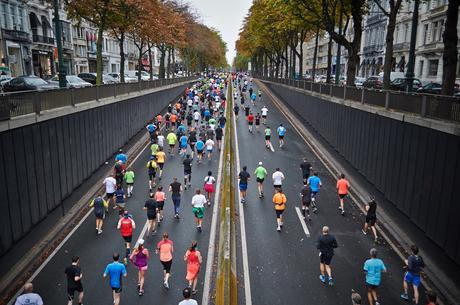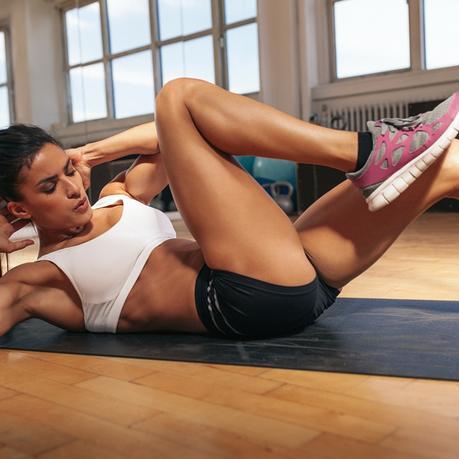
4 Exercises To Avoid To Reduce The Belly Fat
Girl, boy, man or woman. Regardless of age or gender, weight loss is tough. Individuals from all walks of life struggle with weight gain or an inability to shift fat from hard to reach places. Although admittedly losing weight seems to become exponentially more difficult as we age.
We’re never short of advice though. A wealth of information is front and center to entice you to lose weight. It typically revolves around some sort of dietary strategy or a 'remarkable' program, workout, exercise or fitness product. The problem is much of this advice is conflicting or dubious at best.
Today I want to delve into the exercise side of things. Let’s look at how to reduce the belly fat around your midsection by avoiding four of the most overrated and ineffective exercises. You’ll see these exercises popping up time and time again in 'so called' weight loss programs.
Cardio exercises such as treadmill jogging or stationary cycling

Overrated exercises to reduce the belly fat
Do you spend countless hours at the gym sitting on a bike, walking or jogging on the treadmill or perhaps cruising away on the elliptical or cross trainer? If low intensity aerobic exercise is your go-to workout option then you may wish to change up your approach slightly - perhaps incorporating some faster, more explosive anaerobic training into your fat loss program.
Perhaps you have been told by a trainer, friend or colleague that lower intensity exercise keeps you squarely in the fat burning zone, optimising your weight loss. Not only that, it gives you a chance to catch up on a good book at the same time.
Now I will admit this, aerobic or lower intensity cardio does burn more fat relative to carbs. There, I've said it. But that is where the support for this theory ends. Higher intensity workouts burn more total calories from both fuel sources. Not only that, higher intensity interval training (or HIIT as it is commonly known) delivers an accelerated calorie burning rate for several hours after a workout is completed. This is scientifically referred to as post exercise oxygen consumption (EPOC), or the 'afterburn'. By elevating your metabolic rate post workout you will encourage improved fat loss.
HIIT training has a bunch of other benefits too. Not only is it effective in reducing subcutaneous fat stores and belly fat, it also lowers insulin resistance, enhances aerobic and anaerobic fitness, and improves skeletal muscle fat oxidation.
A study by Tremblay et al. compared the impact of exercise intensity on body fatness and skeletal muscle metabolism. The researchers placed 10 subjects on a 15 week high intensity program and a further 17 participants on a 20 week endurance training program. The high intensity program induced a greater reduction in subcutaneous adiposity (or fat) than the steady state group, the researchers concluding that "vigorous exercise favours negative energy and lipid balance to a greater extent than exercise of low to moderate intensity".
Endless crunches or sit ups

How to reduce the belly fat
A recent study examined the effect of abdominal exercises on belly fat. Twenty-four healthy yet sedentary participants between 18 and 40 years old were recruited for the study. The treatment group performed an abdominal workout 5 times per week for 6 weeks. The program consisted of 7 ab specific exercises, with individuals completed two sets of 10 reps. As you would expect... the control group completed no exercise intervention, and maintained a consistent diet throughout the 6 week period. Scientists captured changes in body composition, as well as muscular endurance, throughout the course of the trial.
Now if you were hopeful that the ab training group came out with flatter stomachs or even rock hard abs you will be sorely mistaken! In fact the research team found no significant effect on body weight, body fat percentage, abdominal circumference or abdominal skin fold.
You might argue that this was only a 6 week intervention and the level of abdominal training was insufficient. Perhaps. Although the scientists did establish significantly enhanced muscle endurance within the same period, and several other studies support their findings.
Sorry to be the bearer of bad news... but ab specific training won't help fix your belly fat problems. If you were thinking of cracking away at crunches, sit ups or any other form of stomach exercise to get that glamorous six pack appearance… time to think again. You need to shift the layer of fat from your mid section before you can hope to achieve a sexy stomach… and ab training alone won't do this for you.
Now don't get me wrong… you shouldn't avoid core exercises altogether. A strong core or abdominal region is vitally important for both form and function. However there are more effective exercises for optimising your weight loss efforts.
A focus on machine weights

Free weights best to reduce the belly fat
Ok, 'machine weights' isn't a specific exercise. More a broad categorisation of an exercise type. However the machine vs free weights debate is a common one when it comes to getting results… and achieving weight loss, strength or muscle gains.
First let me concede a key point. Free weights and machine weights can both effectively help your to tone your body or lose excess fat. They can both help provide significant strength gains. And both can be effective in increasing muscle mass or promoting lean muscle development.
You're probably wondering why I am clearly just about to slag off machine weights as a valid option for how to lose belly fat then? Fair enough.
Faced with the choice of machine or free weights for weight loss what should your choose? This can be partly determined by your access to equipment. However if you have access to dumbbells or similar free weights options this should be your primary choice. The good news is that free weights are versatile and typically less expensive than the machine alternative anyway.
So why free weights then? Well there are a couple of key weight loss benefits derived from free weights as opposed to machines. The first is that free weights have the ability to burn more calories than performing the same exercise using a range restricted machine alternative.
The second, but related, benefit is that free weights work a larger volume of muscles simultaneously. Free weights require the engagement of stabilising muscles to maintain form throughout your movement, and more closely mimic real life movement situations. Both of these add up to a more comprehensive training effect.
Some fitness enthusiasts (note I said enthusiasts not experts!) will argue that free weights are better for beginners, and that you should slowly progress to free weights. This is not true. Beginners or experts alike can perform workouts based on free weights such as dumbbells or barbells. They just need to ensure proper technique from the outset.
According to strength and conditioning expert Craig Ballentyne "Machines are inefficient—they target only one or two muscle groups at a time, while bodyweight or dumbbell exercises utilize several muscle groups in one move,"
Let's look at some science to back that up. A study published in the Journal of Strength & Conditioning Research randomly placed 30 previously untrained subjects in one of two groups for a 16 week training intervention. A 'free weights' strength group used a free form resistance device, and a fixed form group utilised a fixed range resistance option.
The free form group increased strength 115% over their baseline levels. The fixed group improved strength as well, however the magnitude of their improvement was less startling, a 57% increase.
Any exercise targeting spot reduction

Targeted fat reduction and reducing belly fat
I mentioned above the fact that crunches or abdominal specific exercises are ineffective for shifting abdominal fat. Let's widen the net here for a second.
There is a widespread belief that fat can be targeted for reduction in a specific area of your body. For example… to lose fat off your thighs, you would train the thighs directly, thus reducing subcutaneous fat and delivering slimmer legs. Unfortunately... this theory does not hold true.
Yes, you're probably constantly see some new fandangled machine advertised as the key to six pack abs or another device that is the 'silver bullet' for body fat reduction. Typically this hails from manufacturers exploiting a lack of knowledge from the general public on the topic of spot reduction.
I'll admit, the idea appears to our intuition. Its reasonable to assume you can remove fat from the part of your body you are specifically training. However, studies have shown this selective training of muscles doesn't assist fat loss.
A study way back in 1971 first looked at this issue. Scientists from the University of California recruited tennis players to assess their dominant vs non dominant arm for irregularities in subcutaneous fat levels. The thought process was that tennis players arms are subjected to vastly difference volumes of exercise and if spot reduction is a 'thing' they should see differences between their hitting and non hitting arms. The researchers found no statistical differences.
More recently, a research team at the University of Connecticut investigated this theory. A 2007 trial included 104 participants and was run over 12 weeks. Participants underwent an upper body resistance-training program schedule focused on training only their non dominant arm. Similar to the 1971 study MRI assessments suggested no spot reduction and that fat loss was more generalised.
That begs the question why? Why does targeted fat loss not work... or why is fat loss more generalised? There are a couple of key reasons. The first is that fat contained in fat cells is not in a form that can be readily used as fuel by your muscles. Triglycerides must be broken down into glycerol and free fatty acids to enter the bloodstream and become available as energy. This breakdown can occur anywhere in the body, not just the area you are focusing your exercise.
There is another reason. The specific exercises you're completing to try to 'spot reduce' fat... are actually not burning many calories anyway. And if you are not significantly shifting your calorie balance... it's not going to have a noticeable impact on fat deposits anyway.
It's better to focus on intensive, total body exercises and workouts that engage a large volume of musculature and are a more efficient calorie-burning response.
What is your favorite exercise for losing weight or theory on how to reduce the belly fat around your stomach area? Let us know below.


posted on 12 August at 13:35
hey guys, This article is really interesting, i was once a victim of body fat but thank God for what i found 3 weeks diet http://tinyurl. com/3weekswl . Brian, who is a world class certified personal trainer and nutritionist created a new system for rapid weight loss which he posted on twitter. He calls it The 3 Week Diet. It's called that because the system can help you lose up 23 pounds (10 kilograms) of pure body fat in just 3 weeks! I didn't believe it at first either until i tried it